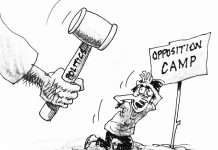
In my last column, I mentioned that there is a need to reintroduce indigenous toys and games as alternatives to gadgets. The aim is to introduce these to our young people and thus save them from too much exposure or addiction to gadgets. What, then, are these toys? The following are samples of those traditional, ethnic, cultural, or indigenous toys:
Badlot first comes to mind. It is made of that sugarcane-like grass called locally as puti, tigbaw, or lupaw. Indeed, this grass looks like sugarcane, but it is very thin compared to the latter. The base of its stem is bigger and more sturdy. It is being cut off at the base, cleaned, and from it, one to one-and-a-half feet length is to be removed from the plant, cleaned, and that would be it—a badlot to play with. Two players are required, each with a badlot in hand. One will lay his badlot on the ground, while the other one will hit it using his badlot. They will have to take turns in doing this. The aim is to destroy the other person’s badlot. The badlot that gets badly damaged first is the loser.
Another example of old toys is called balugsay. This is composed of little sticks made of bamboo. They look like barbeque sticks but are shorter in their uniform length. Two players are required to play these, using their palms that alternately face up and down, with the balugsay sticks on top. Suddenly, the player lets go of the sticks and quickly snatches certain numbers of those sticks. They have to take turns in doing this after each player gets disqualified for not being able to snatch the required number of sticks.
Satom, or sato in other places, is another indigenous toy. It’s a pair of bigger sticks made of wood or solid rattan, one is longer like a small baseball bat, and the other one is short, around 5 or 6 inches long. This could be played by a pair of players, or by two groups of players. There should be a small hole in the ground on which the smaller stick is placed.
There are three ways of using the toy: one is to eject the small stick using the bigger one as far as the player can, while the opponents watch on the spots where they think the thing will fall. If they can catch it, the player gets disqualified to give way to his next groupmate.
If the watchers cannot catch the falling stick, then the distance from the hole to that short stick will be measured using the longer stick. The next move is to bat the small stick as strongly as the player can while the opponents try to catch it to disqualify the player. If they fail, the distance will be measured as well. The third move will be made—the stick will be placed in the hole, its tip sticking out. The player strikes that stick and as it flies upward, he will have to bat it as strongly as he can. The watching opponents in front will have to catch it to disqualify the player. If they fail, then the distance from the hole to where the short stick fell will be measured again. So it’s a contest on which group accumulates the highest number of points.
From the leaves of coconuts, the native toy called mola-bola can be made. The leaves are being fashioned into a ball-like form. Once done, it can be used in many games, one of which is what the children call fire-fireay. It is played by two groups, each of them armed with a ball. Every member of a group hit by the ball is removed from the active players until all members get disqualified. The group with surviving players wins.
(To be continued)



